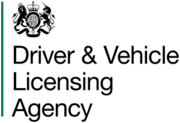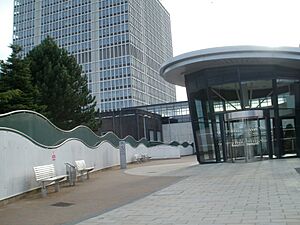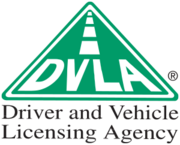Driver and Vehicle Licensing Agency facts for kids
 |
|
 The main DVLA building in Swansea, Wales |
|
| Agency overview | |
|---|---|
| Formed | 1965 |
| Type | Executive agency |
| Jurisdiction | United Kingdom |
| Headquarters | Swansea, Wales |
| Employees | 5,715 |
| Agency executive |
|
| Parent agency | Department for Transport |
The Driver and Vehicle Licensing Agency, or DVLA, is a part of the British government. Its main job is to keep a record of all drivers in Great Britain and all vehicles in the entire United Kingdom.
The DVLA is responsible for giving out driving licences. It also collects a tax called vehicle excise duty, which is sometimes known as road tax. The money from this tax helps pay for roads and other transport projects. The agency also sells special number plates called personalised registrations.
The DVLA is an executive agency, which means it works for the Department for Transport. Its main office is a large 16-story building in Swansea, Wales.
In the past, the DVLA had 39 local offices across Great Britain. People could visit these offices to get a licence or do other paperwork. However, all these local offices were closed in 2013. Now, most of the DVLA's work is done from its main centre in Swansea. People contact the DVLA by mail, phone, or online.
Contents
What Does the DVLA Do?
The DVLA handles several important tasks related to driving and vehicles in the UK.
Driving Licences and Vehicle Tax
One of the DVLA's biggest jobs is issuing driving licences to people who have passed their driving test. They keep a database of everyone who is legally allowed to drive.
The agency also makes sure that all vehicle owners pay their vehicle tax. Since 2004, people can pay this tax online or by phone. They can also still pay it at a Post Office.
Special Vehicle Registrations
The DVLA also manages registrations for special types of vehicles. This includes:
- British Forces in Germany: Civilian cars used by members of the British Forces Germany and their families are registered with the DVLA.
- Diplomatic Vehicles: Official cars used by diplomats from other countries are also registered through the DVLA.
History of the DVLA
Before the DVLA was created, local councils were in charge of registering vehicles. This system started with the Motor Car Act 1903.
In 1965, the government decided to create a single, central system for the whole country. A new office, the Driver and Vehicle Licensing Centre, was built in Swansea. It officially opened in 1969 and took over the job from the local councils.
In April 1990, the centre was renamed the Driver and Vehicle Licensing Agency (DVLA). It became an executive agency of the Department for Transport.
The DVLA's Databases
The DVLA keeps two very large and important databases: one for vehicles and one for drivers.
The Vehicle Database
The vehicle database holds information on every car, van, and motorcycle in the UK. Each vehicle is tracked using its unique vehicle identification number (VIN), not just its number plate. This helps make sure that every vehicle has only one official registration.
This database is used for many reasons. For example, the police can use it to find the owner of a car that was caught speeding by a speed camera. It is also used to identify cars that have not paid the congestion charge in London.
Companies can also pay a small fee to access information from the database. This is often used by people who want to check the history of a used car before they buy it.
The Driver Database
The driver database holds information on about 42 million people with a driving licence in the UK. This database helps the DVLA issue new licences and keep track of who is allowed to drive.
Police forces and courts also use this database. It helps them enforce traffic laws and make sure our roads are safe. Sometimes, public groups have been banned from using the database if they did not use it correctly.
See also
- Driver and Vehicle Standards Agency
- Driver and Vehicle Agency


